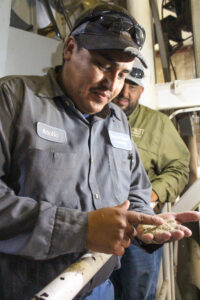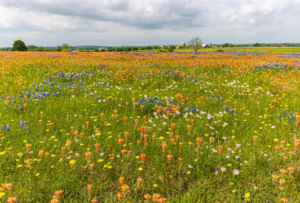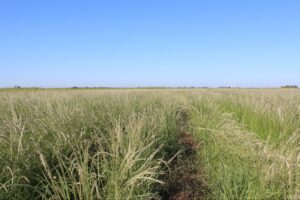These days, it feels like we’re always hearing about droughts somewhere: California, Utah, the Great Plains – regions all across the U.S. have issues with the loss of water and rivers and lakes down. Even with recent rainfall this year, water is still a critical issue.
While there is more to dealing with water scarcity than just planting natives, combatting drought with native grasses is an amazing place to start. Native grasses have been here longer than any of us, and they are perfectly adapted to their home terrain in amazing ways, making them natural experts at handling seasons of both drought and moisture. It’s not an exaggeration to say that they’re one of our best tools in the fight against water scarcity.
Today, we’ll share some crucial steps you can take to begin combatting drought with native grasses, but before we dive in, let’s talk about how to use wet seasons to prepare for eventual periods of drought.
Use Wet Seasons to Prepare for Drought
Many regions in the U.S. are currently experiencing wet seasons with high levels of rainfall. While moisture like this is always something to be thankful for, it also presents a perfect opportunity to do things that will prepare your land for the next drought.
Now is the best time to plant native grasses and species to have them established for any future dry seasons. Because natives have such deep and long roots, you will experience multiple benefits, both right now and for the future:
- Once native species are established, they can help reduce flooding that would occur otherwise.
- The roots of native species allow for standing water to infiltrate more quickly and effectively, keeping it from staying ponded as long and allowing your land to make as much use of the water for as long as possible.
- High levels of water will allow for your seed to establish quickly without needing as much watering from you. If you plant a blend with some quick-growing species, you will also begin to see wildlife embrace this habitat.
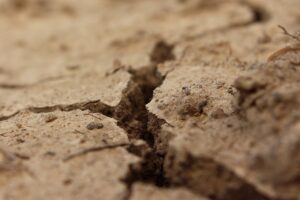 Want to take advantage of recent rains, but not sure what will be the best choice to plant for your acreage? Contact our team and we will put you in touch with one of our Reclamation Specialists to help you choose native blends that establish quickly and help your area retain moisture for future dry spells.
Want to take advantage of recent rains, but not sure what will be the best choice to plant for your acreage? Contact our team and we will put you in touch with one of our Reclamation Specialists to help you choose native blends that establish quickly and help your area retain moisture for future dry spells.
Combatting Drought with Native Grasses, Forbs, and Legumes
Native grasses, forbs, and legumes are highly adapted to their region and climate. These native species have evolved over countless generations to withstand the unique challenges of their local conditions, making them exceptionally resilient and, most importantly, a proven tool in combatting drought.
For instance, the roots of some native grasses reach extraordinary depths, accessing water sources far beyond the reach of typical grass seed. This means they need less watering, a critical characteristic in regions that experience low annual rainfall or in areas where the aquifer has been depleted.
Think of your favorite football team. Regardless of whether you’re an Aggie or a Red Raider, you know it’s important that every player knows his position and plays it well. That’s exactly how native grassland ecosystems work. Every plant, animal, insect, and even the microscopic organisms in the soil are team players. They each have specific roles that all work together to keep the soil healthy, let water flow as needed, and move nutrients around the system.
A field flourishing with different types of native prairie grasses is an incredible picture of beautiful biodiversity. Native grasses, forbs, and legumes grow and survive in a variety of ways and conditions, which is good for life above and below ground. Just like your favorite football team, they don’t all play the same position, or in this case, use water and nutrients from the soil at the same rate and time. A variety of native grasses will have a variety of growth curves and a variety of root depths in the soil profile and will draw moisture at different times during the year, depending upon their growing season. They each have their own “favorite spots” to draw from, so they don’t fight over the same resources. Combatting drought with native grasses isn’t a silver bullet for water issues, but it’s an excellent place to start.
Seed Spec: Your Tool for Finding the Right Native Species for Any Region
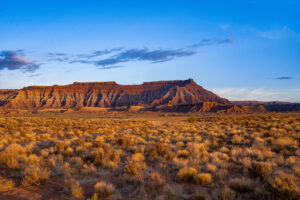 Choosing the right kinds of plants to grow is as important as picking the right players for a team. For any project, whether farming, reclamation, or restoration after construction, there’s a huge advantage in considering the entire spectrum of soil, species composition, and the immediate ecosystem when designing a native seed blend.
Choosing the right kinds of plants to grow is as important as picking the right players for a team. For any project, whether farming, reclamation, or restoration after construction, there’s a huge advantage in considering the entire spectrum of soil, species composition, and the immediate ecosystem when designing a native seed blend.
While you can find some information online to help you decide which species will grow well in a specific region, our team has made it simple for you to take that information a step further.
Using our proprietary tool, Seed-Spec, we identify both the right native species and planting rates for a specific location. Seed-Spec is a geo-spatially enabled web application we use to develop custom native seed blends for the re-vegetation of your next project.
Our in-depth information allows you to plant and grow native grasses, forbs, and legumes adapted to succeed, whether your goals are reclamation, restoration, a DOT project, or pollinator habitat creation.
Seed-Spec takes the guesswork out of reclamation and conservation, saving you considerable time and money for any project.
Five Steps for Combatting Drought Using Native Grasses
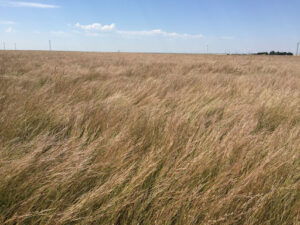 Step 1: Let It Be. You might be surprised to hear a company that makes a living selling native seeds tell you to avoid planting, but we understand firsthand that there are seasons where the very best thing you can do for your acreage is to leave it undisturbed. If you’re struggling with water loss and drought and you do have some sort of ground cover, your best course of action might be to let what soil coverage you have to do its job and try to maintain as much moisture as possible.
Step 1: Let It Be. You might be surprised to hear a company that makes a living selling native seeds tell you to avoid planting, but we understand firsthand that there are seasons where the very best thing you can do for your acreage is to leave it undisturbed. If you’re struggling with water loss and drought and you do have some sort of ground cover, your best course of action might be to let what soil coverage you have to do its job and try to maintain as much moisture as possible.
Our entire team is just as passionate about conversation as we are about building a successful business. Our team of Reclamation Specialists will offer clear, honest guidance that helps you know the right course of action to take to respect and maintain the biodiversity you currently have.
Step 2: Identify Your Native Grasses and Blends: Each region has distinct native grass species. From the tallgrass prairies of the Midwest to the High Plains of West Texas, knowing which native grasses and species are local to your area is the first step towards an eco-friendly transition. If you use Seed-Spec, as mentioned above, you can determine this information in about the same amount of time it takes you to create a Facebook post.
At Bamert Seed, we offer over 400 species of high-quality native grasses, forbs, and legumes. Some drought-tolerant native species we recommend include:
We offer customized guidance to help you identify the native plants that will flourish in your area. With 70 years of expertise, we can guide you in choosing the ideal seed mix based on your region, soil type, and sunlight exposure. We offer consultations with our customers, not as an “added feature,” but as a primary component of our service: ensuring that you have seeds adapted to succeed.
Step 3: Sowing and Establishing Your Native Grasses: It’s not just about scattering the seeds; it’s about ensuring that they take root. Proper soil preparation, timing, and initial watering are crucial in the establishment phase. Going back to our football discussion, it’s impossible to over-emphasize the value of good equipment. Even the best player is more likely to fumble if he doesn’t have strategic gear. Successful sowing skyrockets when you plant with the proper equipment, specifically a native seed drill, engineered to sow at the precise depth your native seeds require. We can walk you through this, and everything else it takes to sow native grasses successfully.
Step 4: Long-Term Maintenance of Your Native Grass Patch: Once established, native grasses are impressively low-maintenance. They typically require less frequent watering and mowing than conventional grass, saving time and resources. In fact, the best thing you can do after planting is to let your native species grow a year or two before allowing any grazing.
Step 5: Seeing the Results: As anyone who has ever built anything worthwhile knows, “instant results” often wither. Just as good teams take time to nurture and develop, so do hearty native grasslands.
In the first year, root systems–which one day will be substantial, hold water, and prevent erosion–are developing, unseen. But if there’s one thing we know how to do as farmers, ranchers, and Texans, it is to patiently wait and trust that good things will grow. Because native species are perfectly adapted to their environment, you see visible benefits and results: an increase in local wildlife, higher numbers of pollinators, and native plants with strong root systems that take in and hold moisture.
The Future is Green and Native
Native grasses offer myriad benefits. They’re great team players. They conserve water, provide habitat for local wildlife and pollinators, improve soil health, and reduce the need for fertilizers and pesticides. These grasses, forbs, and legumes play a critical role in tackling drought and preserving precious water resources, and stewarding a more sustainable and resilient land.
If you’re looking to begin planning your project, our recommendation is always to use a blend to establish the highest levels of biodiversity.
Here are some of our most popular blends that are also highly drought resistant.
- Deluxe Prairie Blend
- Premium Pasture Blend
- Steep Slope Blend (grows quickly and is resilient to the heat of steep slopes)

